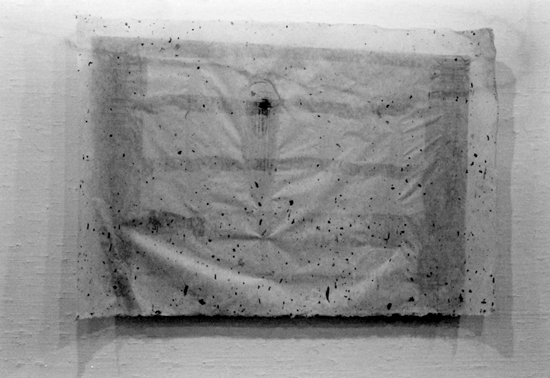Object & Installation

형의 상관
1973, 골판지, 맷돌, 한지, 로프, 제1회 개인전, 명동화랑(1973.9.27-10.1)
바닥에 골판지가 깔려 있고, 그 위에는 한지로 싼 맷돌이 놓여 있으며 다시 그 위에는 맷돌과 비슷한 크기의 로프 뭉치가 올려져 있다. 골판지와 한지의 평면성(flatness)은 ‘사물성’(objecthood)의 개념으로 인식되며, 로프의 선적(linear) 특성도 그것이 감아져 뭉치가 될 때는 ‘사물’로서의 덩어리(mass) 개념으로 인식된다. 강국진은 ‘형의 상관’이라는 주제로 제1회 개인전을 할 당시, 가공되지 않은 돌을 사용하기도 했으며, 이 작품의 경우처럼 인간의 손길을 거친 돌을 사용하기도 했다. 전통적으로 한국에서 곡식을 갈 때 썼던 맷돌은 성분 자체가 ‘자연의 돌’이지만 인간의 ‘도구로서의 기능’을 갖는 ‘가공물’이기도 하다. 각각의 ‘형’들은 ‘상관’ 관계를 맺으며 새로운 차원의 ‘조합된 오브제’가 된다. (김미경, 미술사학 박사 / 강남대 교수 / 한국예술연구소KARI 대표
Interrelation of Forms
1973, corrugated cardboard, millstone, Korean paper, rope, the 1st solo exhibition, gallery Myungdong (27 September-1st October 1973)
A corrugated cardboard is laid on the floor. On it, there is a millstone covered and wrapped with Korean paper. Here, the cardboard and the paper is conceived as in ‘objecthood’, the linearity of rope is now considered as a thing that entails mass. Kang used both natural stones – in ‘Interrelationship of Forms’, his first solo exhibition – and processed ones like the millstones, but didn’t prefer one over another. Considering the function and use of millstones, one needs to relate the use of them to the fact that millstones themselves are natural in substance, but at the same time tools used by human hands, which makes them artificial simultaneously. Hence, the outcome can be described as an ‘integrated object’ that has a formative relationship with other components. (Mikyung Kim / Professor of Art History at Kangnam University / Director of Korean Art Research Institute)
KUKJIN KANG









